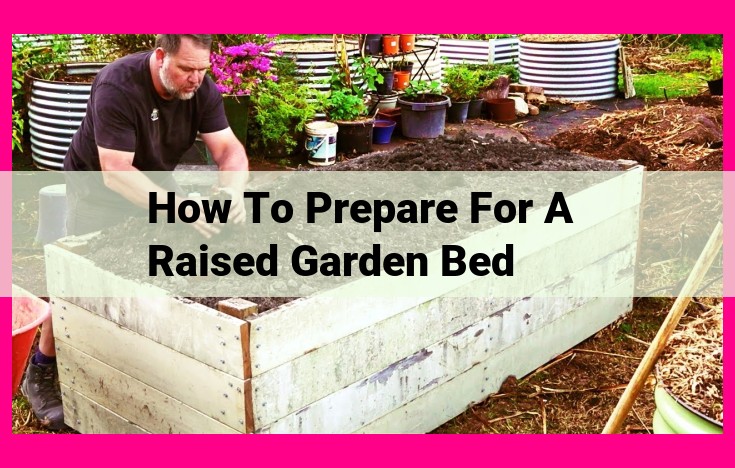How To Create A Thriving Raised Garden Bed: A Step-By-Step Guide

To prepare for a raised garden bed, gather essential materials like lumber, screws, landscaping fabric, mulch, and topsoil. Plan the bed’s size and location, then construct the frame and line it with fabric to prevent weeds. Fill the bed with a mixture of topsoil, compost, and amendments to ensure good drainage and fertility. Finally, add plants or seeds, and water them thoroughly.
Essential Materials for a Thriving Garden
Lumber:
For building sturdy raised garden beds or trellises, select pressure-treated or cedar lumber, known for its durability and resistance to decay.
Screws or Nails:
Secure your garden structures with galvanized or rust-resistant screws or nails. These will withstand outdoor elements and ensure the longevity of your creations.
Landscaping Fabric:
Suppress weeds and maintain moisture levels by lining your garden beds with landscaping fabric. Choose a permeable fabric that allows water and air to pass through.
Mulch:
A layer of organic mulch, such as compost, straw, or bark, will protect your soil from moisture loss, moderate soil temperature, and add nutrients to the ecosystem.
Topsoil or Garden Mix:
Provide your plants with a nutrient-rich foundation by filling your garden beds with high-quality topsoil or garden mix. Enrich the soil with organic matter, such as compost or manure, to enhance fertility.
Plants or Seeds:
Choose plants or seeds that are suitable for your climate and the space you have available. Research and select varieties that align with your gardening goals and preferences.
Tools:
Equip yourself with the right tools to make gardening a breeze. Essential tools include:
- Saw: For cutting lumber
- Drill: For driving screws or bolts
- Screwdriver or Nail Gun: For securing structures
- Shovel or Spade: For digging and transplanting
- Rake: For leveling soil and removing debris
- Level: For ensuring level surfaces when building structures
Step-by-Step Guide to Building a Raised Garden Bed
Prepare to transform your gardening experience with the step-by-step guide to building a raised garden bed. Embark on this rewarding journey as we guide you through the essential steps, empowering you to cultivate a ** thriving** oasis right in your backyard.
Site Selection:
Choose the perfect location for your raised garden bed. Consider sunlight, drainage, and accessibility. Select a spot that receives ample sunlight throughout the day and has well-drained soil.
Frame Construction:
Determine the size and shape of your raised garden bed. Gather the necessary lumber, screws or nails, and construct the frame according to your desired dimensions. Use durable materials that can withstand the elements.
Lining the Bed:
To prevent soil erosion and weed growth, line the bed with landscaping fabric. Secure it to the frame with staples or landscaping pins. This barrier will help retain moisture and suppress unwanted vegetation.
Filling the Bed:
Fill your raised garden bed with a mixture of topsoil or garden mix. Consider amending the soil with compost or organic matter to improve drainage and fertility.
Planting:
Plan your plant layout carefully, considering compatibility and growth habits. Dig holes in the soil, ensuring proper spacing between plants. Gently remove plants from their containers and plant them in the holes. Water thoroughly after planting.
Embark on this rewarding gardening adventure, and witness your plants flourish in their custom-built raised garden bed. Follow these step-by-step instructions, and your backyard will transform into a vibrant sanctuary where nature thrives.
Resources for Gardeners
For budding gardeners embarking on their green-thumbed adventures, navigating the unfamiliar terrain can be daunting. Fear not, as a plethora of resources awaits to guide you along the way.
Garden Centers:
These veritable plant havens offer a vast selection of flora and fauna to adorn your garden with their vibrant hues and fragrant aromas. From blooming annuals to graceful perennials, you’ll find the perfect botanical companions for your outdoor oasis. Garden centers also provide essential materials such as soil, mulch, and fertilizers to nourish your plants and ensure their thriving.
Landscaping Companies:
If you crave professional expertise to elevate your gardening endeavors, seek the services of seasoned landscaping companies. From design and installation to maintenance and consultation, these experts can transform your backyard into a verdant paradise. Their knowledge and experience will ensure your garden thrives under their meticulous care.
Soil Testing Labs:
The key to a flourishing garden lies in fertile soil. Understanding the composition of your soil is crucial for optimizing plant nutrition and growth. Soil testing labs analyze soil samples to provide insightful reports on pH levels, mineral content, and organic matter. Armed with this data, you can make informed decisions about soil amendments and cultivation practices.
National Gardening Association and American Community Gardening Association:
Connect with seasoned gardeners and community enthusiasts through these esteemed organizations. The National Gardening Association offers a wealth of educational resources, workshops, and gardening tips to empower you on your green journey. Likewise, the American Community Gardening Association promotes the social and environmental benefits of gardening through community-oriented projects and resources.
Sustainable Gardening Practices for a Thriving Garden
Embrace eco-friendly gardening practices to minimize environmental impact and maximize garden health.
Water Conservation Techniques
Drip irrigation delivers water directly to plant roots, reducing evaporation and water waste. Install drip lines or soaker hoses to efficiently distribute water.
Rain barrels collect rainwater for watering. Place barrels under downspouts or use above-ground tanks to store precious rainwater for drought-prone periods.
Composting for Organic Soil Enrichment
Compost is a natural fertilizer that improves soil structure, water retention, and nutrient availability. Create your own compost by layering organic materials like kitchen scraps, yard waste, and paper products.
Organic soil amendments like peat moss, manure, and compost enrich the soil without synthetic chemicals. These natural additives promote microbial activity, improve drainage, and enhance plant growth.
By adopting these sustainable practices, you protect the environment, conserve resources, and promote a thriving garden. Embracing eco-friendly gardening is a rewarding way to create a beautiful and sustainable outdoor oasis.